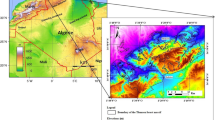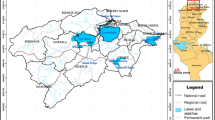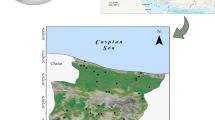Abstract
Information on fire probability is of vital importance to environmental and ecological studies as well as to fire management. This study aimed at comparing two forest fire probability mapping techniques, one based primarily on freely distributed EO (Earth observation) data from Landsat imagery, and another one based purely on GIS modeling. The Normalized Burn Ratio (NBR) computed from Landsat data was used to detect the high fire severity and probability area based on the NBR difference between pre- and post-fire conditions. The GIS-based modeling was based on a multi criterion evaluation technique, into which other attributes like anthropogenic and natural sources were also incorporated. The ability of both techniques to map forest fire probability was evaluated for a region in India, for which suitable ancillary data had been previously acquired to support a rigorous validation. Subsequently, a conceptual framework for the prediction of high fire probability zones in an area based on a newly introduced herein data fusion technique was constructed. Overall, the EO-based technique was found to be the most suitable option, since it required less computational time and resources in comparison to the GIS-based modeling approach. Furthermore, the fusion approach offered an appropriate path for developing a forest fire probability identification model for long-term pragmatic conservation of forests. The potential fusion of these two modeling approaches may provide information that can be useful to forest fire mitigation policy makers, and assist at conservation and resilience practices.









Similar content being viewed by others
References
Albert-Green A, Dean C, Martell DL, Woolford DG (2012) A methodology for investigating trends in changes in the timing of the fire season with applications to lightning-caused forest fires in Alberta and Ontario, Canada. Can J For Res 43:39–45
Alexandridis TK, Lazaridou E, Tsirika A, Zalidis GC (2009) Using Earth Observation to update a Natura 2000 habitat map for a wetland in Greece. J Environ Manag 90:2243–2251
Banerjee R, Srivastava PK (2013) Reconstruction of contested landscape: detecting land cover transformation hosting cultural heritage sites from central India using remote sensing. Land Use Policy 34:193–203
Castedo-Dorado F, Rodríguez-Pérez JR, Marcos-Menéndez JL, Alvarez-Taboada MF (2011) Modelling the probability of lightning-induced forest fire occurrence in the province of León (NW Spain). For Syst 20:95–107
Charabi Y, Gastli A (2011) PV site suitability analysis using GIS-based spatial fuzzy multi-criteria evaluation. Renew Energy 36:2554–2561
Chuvieco E, Cocero D, Riano D, Martin P, Martınez-Vega J, De La Riva J, Pérez F (2004) Combining NDVI and surface temperature for the estimation of live fuel moisture content in forest fire danger rating. Remote Sens Environ 92:322–331
Chuvieco E, Aguado I, Yebra M, Nieto H, Salas J, Martín MP, Vilar L, Martínez J, Martín S, Ibarra P (2010) Development of a framework for fire risk assessment using remote sensing and geographic information system technologies. Ecol Model 221:46–58
De Santis A, Asner GP, Vaughan PJ, Knapp DE (2010) Mapping burn severity and burning efficiency in California using simulation models and Landsat imagery. Remote Sens Environ 114:1535–1545
Eastman JR (1993) IDRISI version 4.1. Clark University, Worcester
Epting J, Verbyla D, Sorbel B (2005) Evaluation of remotely sensed indices for assessing burn severity in interior Alaska using Landsat TM and ETM+. Remote Sens Environ 96:328–339
Erden T, Coşkun M (2010) Multi-criteria site selection for fire services: the interaction with analytic hierarchy process and geographic information systems. Nat Hazards Earth Syst Sci 10:2127–2134
Escuin S, Navarro R, Fernandez P (2008) Fire severity assessment by using NBR (Normalized Burn Ratio) and NDVI (Normalized Difference Vegetation Index) derived from LANDSAT TM/ETM images. Int J Remote Sens 29:1053–1073
Fernández-Manso A, Fernández-Manso O, Quintano C (2016) SENTINEL-2A red-edge spectral indices suitability for discriminating burn severity. Int J Appl Earth Obs Geoinf 50:170–175
Gorsevski PV, Donevska KR, Mitrovski CD, Frizado JP (2012) Integrating multi-criteria evaluation techniques with geographic information systems for landfill site selection: a case study using ordered weighted average. Waste Manag 32:287–296
Gupta M, Srivastava PK (2010) Integrating GIS and remote sensing for identification of groundwater potential zones in the hilly terrain of Pavagarh, Gujarat, India. Water Int 35:233–245
Horton RE (1945) Erosional development of streams and their drainage basins; hydrophysical approach to quantitative morphology. Geol Soc Am Bull 56:275–370
Illera P, Fernandez A, Delgado J (1996) Temporal evolution of the NDVI as an indicator of forest fire danger. Int J Remote Sens 17:1093–1105
Imperatore P, Azar R, Calò F (2017) Effect of the vegetation on backscattering: an investigation based on Sentinel-1 observations. IEEE J Sel Top Appl Earth Obs Remote Sens 10:4478–4492
Ireland G, Petropoulos GP, Carlson TN, Purdy S (2015) Addressing the ability of a land biosphere model to predict key biophysical vegetation characterisation parameters with Global Sensitivity Analysis. Environ Model Softw 65:94–107
Jaiswal RK, Mukherjee S, Raju KD, Saxena R (2002) Forest fire risk zone mapping from satellite imagery and GIS. Int J Appl Earth Obs Geoinf 4:1–10
Joseph S, Anitha K, Murthy M (2009) Forest fire in India: a review of the knowledge base. J For Res 14:127–134
Ju J, Roy DP, Vermote E, Masek J, Kovalsky V (2012) Continental-scale validation of MODIS-based and LEDAPS Landsat ETM+ atmospheric correction methods. Remote Sens Environ 122:175–184
Kalivas D, Petropoulos GP, Athanasiou I, Kollias V (2013) An intercomparison of burnt area estimates derived from key operational products: analysis of Greek wildland fires 2005–2007. Nonlinear Process Geophys 20:1–13
Karamesouti M, Petropoulos GP, Papanikolaou ID, Kairis O, Kosmas K (2016) Erosion rate predictions from PESERA and RUSLE at a mediterranean site before and after a wild- fire: comparison and implications. Geoderma 261:44–58
Key CH, Benson NC (1999) The normalized burn ratio (NBR): a landsat TM radiometric measure of burn severity. USDA, Bozeman. http://nrmsc.usgs.gov/research/ndbr.htm. Accessed 27 April 2016
Kiran Chand T, Badarinath K, Krishna Prasad V, Murthy M, Elvidge CD, Tuttle BT (2006) Monitoring forest fires over the Indian region using Defense Meteorological Satellite Program-Operational Linescan System nighttime satellite data. Remote Sens Environ 103:165–178
Knorr W, Pytharoulis I, Petropoulos GP, Gobron N (2011) Combined use of weather forecasting and satellite remote sensing information for fire risk, fire and fire impact monitoring. Comput Ecol Softw 1:112–120
Lhermitte S, Verbesselt J, Verstraeten WW, Veraverbeke S, Coppin P (2011) Assessing intra-annual vegetation regrowth after fire using the pixel based regeneration index. ISPRS J Photogramm Remote Sens 66:17–27
Mallinis G, Koutsias N (2012) Comparing ten classification methods for burned area mapping in a Mediterranean environment using Landsat TM satellite data. Int J Remote Sens 33:4408–4433
Maselli F, Rodolfi A, Bottai L, Romanelli S, Conese S (2000) Classification of Mediterranean vegetation by TM and ancillary data for the evaluation of fire risk. Int J Remote Sens 21:3303–3313
Neteler M, Mitasova H (2008) Open source GIS: a GRASS GIS approach, number 773 in the international series in engineering and computer science. Springer, New York
Nguyen H, Cressie N, Braverman A (2012) Spatial statistical data fusion for remote sensing applications. J Am Stat Assoc 107:1004–1018
Nioti F, Dimopoulos P, Koutsias N (2011) Correcting the fire scar perimeter of a 1983 wildfire using USGS-archived Landsat satellite data. GISci Remote Sens 48:600–613
Pandey PC, Sharma LK, Nathawat MS (2012) Geospatial strategy for sustainable management of municipal solid waste for growing urban environment. Environ Monit Assess 184:2419–2431
Patel DP, Dholakia MB, Naresh N, Srivastava PK (2011) Water harvesting structure positioning by using geo-visualization concept and prioritization of mini-watersheds through morphometric analysis in the Lower Tapi Basin. J Indian Soc Remote Sens 40:299–312
Pereira P, Úbeda X, Martin D, Mataix-Solera J, Guerrero C (2011) Effects of a low severity prescribed fire on water-soluble elements in ash from a cork oak forest located in the northeast of the Iberian Peninsula. Environ Res 111:237–247
Petropoulos GP, Griffiths HM, Kalivas DP (2014) Quantifying spatial and temporal vegetation recovery dynamics following a wildfire event in a Mediterranean landscape using EO data and GIS. Appl Geogr 50:120–131
Pohl C, Van Genderen J (1998) Review article multisensor image fusion in remote sensing: concepts, methods and applications. Int J Remote Sens 19:823–854
Roy DP, Boschetti L, Trigg SN (2006) Remote sensing of fire severity: assessing the performance of the normalized burn ratio. Geosci Remote Sens Lett IEEE 3:112–116
Saaty TL (1980) The analytical hierarchy process. McGraw Hill, New York, USA
Saaty TL, Vargas LG (2013) Criteria for evaluating group decision-making methods. Decision making with the analytic network process. Springer, Berlin
Saha S (2002) Anthropogenic fire regime in a deciduous forest of central India. Curr Sci 82:1144–1147
Singh SK, Srivastava PK, Gupta M, Thakur JK, Mukherjee S (2014) Appraisal of land use/land cover of mangrove forest ecosystem using support vector machine. Environ Earth Sci 71:2245–2255
Spies TA, Lindenmayer DB, Gill AM, Stephens SL, Agee JK (2012) Challenges and a checklist for biodiversity conservation in fire-prone forests: perspectives from the Pacific Northwest of USA and Southeastern Australia. Biol Conserv 145:5–14
Srivastava PK, Gupta M, Mukherjee S (2012a) Mapping spatial distribution of pollutants in groundwater of a tropical area of India using remote sensing and GIS. Appl Geom 4:21–32
Srivastava PK, Han D, Gupta M, Mukherjee S (2012b) Integrated framework for monitoring groundwater pollution using a geographical information system and multivariate analysis. Hydrol Sci J 57:1453–1472
Srivastava PK, Han D, Rico-Ramirez MA, Bray M, Islam T (2012c) Selection of classification techniques for land use/land cover change investigation. Adv Space Res 50:1250–1265
Tachiiri K (2005) Calculating NDVI for NOAA/AVHRR data after atmospheric correction for extensive images using 6S code: a case study in the Marsabit District, Kenya. ISPRS J Photogramm Remote Sens 59:103–114
Turner W, Spector S, Gardiner N, Fladeland M, Sterling E, Steininger M (2003) Remote sensing for biodiversity science and conservation. Trends Ecol Evol 18:306–314
Vadrevu KP, Badarinath K (2009) Spatial pattern analysis of fire events in Central India—a case study. Geocarto Int 24:115–131
Vadrevu KP, Eaturu A, Badarinath K (2006) Spatial distribution of forest fires and controlling factors in Andhra Pradesh, India using spot satellite datasets. Environ Monit Assess 123:75–96
Vadrevu KP, Eaturu A, Badarinath K (2010) Fire risk evaluation using multicriteria analysis—a case study. Environ Monit Assess 166:223–239
Van Wagtendonk JW, Root RR, Key CH (2004) Comparison of AVIRIS and Landsat ETM+ detection capabilities for burn severity. Remote Sens Environ 92:397–408
van der Werf G, Randerson J, Giglio L, Collatz G, Kasibhatla P, Arellano A (2006) Interannual variability of global biomass burning emissions from 1997 to 2004. Atmos Chem Phys 6:3175–3226
Vermote EF, Kotchenova S (2008) Atmospheric correction for the monitoring of land surfaces. J Geophys Res 113:D23S90
Vermote EF, Tanré D, Deuze JL, Herman M, Morcette JJ (1997) Second simulation of the satellite signal in the solar spectrum, 6S: an overview. Geosci Remote Sens IEEE Trans 35:675–686
Vhengani L, Frost P, Lai C, Booi N, van den Dool R, Raath W (2015) Multitemporal burnt area mapping using Landsat 8: merging multiple burnt area indices to highlight burnt areas. In: IEEE international geoscience and remote sensing symposium, pp 4153–4156. https://doi.org/10.1109/IGARSS.2015.7326740
Wald L, Ranchin T, Mangolini M (1997) Fusion of satellite images of different spatial resolutions: assessing the quality of resulting images. Photogramm Eng Remote Sens 63:691–699
Whyte A, Ferentinos K, Petropoulos GP (2018) A new synergistic approach for monitoring wetlands using sentinels − 1 and 2 data with object-based machine learning algorithms. Environ Model Softw 104:40–54
Acknowledgements
The authors would like to thank the Commonwealth Scholarship Commission, British Council, United Kingdom and Ministry of Human Resource Development, Government of India for providing the necessary support and funding for this research. Authors gratefully acknowledge as well the United Stated Geological Survey (USGS) for the free access to the Landsat satellite images. Dr. Petropoulos’s contribution to this work has been supported by the EU Marie Curie Project ENViSIon-EO (Project contract ID 752094) and the NERC’s Newton Fund RCUK project Towards a Fire Early Warning System for Indonesia (ToFEWSI). The views expressed here are those of the authors solely and do not constitute a statement of policy, decision, or position on behalf of NASA or the authors' affiliated institutions.
Funding
This research received funding from the Commonwealth Scholarship Commission, British Council, United Kingdom and Ministry of Human Resource Development, Government of India.
Author information
Authors and Affiliations
Contributions
Conceptualization, PKS; methodology, PKS, KS, MG, GP and SKS; software, KS, MG and SKS; formal analysis and validation, MG, SKS and TI; X.X.; writing-original draft preparation, all co-authors; writing-review and editing, all co-authors.
Corresponding author
Ethics declarations
Conflict of interest
The authors declare no conflict of interest.
Additional information
Publisher’s Note
Springer Nature remains neutral with regard to jurisdictional claims in published maps and institutional affiliations.
Rights and permissions
About this article
Cite this article
Srivastava, P.K., Petropoulos, G.P., Gupta, M. et al. Deriving forest fire probability maps from the fusion of visible/infrared satellite data and geospatial data mining. Model. Earth Syst. Environ. 5, 627–643 (2019). https://doi.org/10.1007/s40808-018-0555-5
Received:
Accepted:
Published:
Issue Date:
DOI: https://doi.org/10.1007/s40808-018-0555-5




